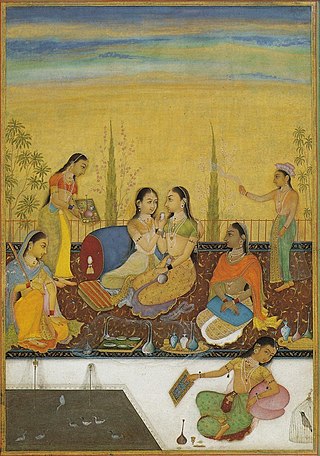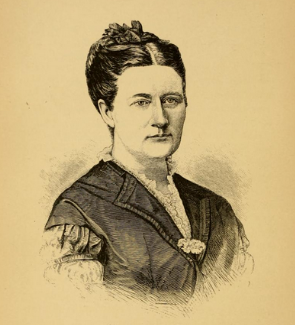
Zenana literally meaning "of the women" or "pertaining to women", in Persian language contextually refers to the part of a house belonging to a Muslim, Sikh, or Hindu family in the Indian subcontinent which is reserved for the women of the household. The zenana are the inner apartments of a house in which the women of the family live. The outer apartments for guests and men are called the mardana. Conceptually in those that practise purdah, it is the equivalent in the Indian subcontinent of the harem.
The Church of England Zenana Missionary Society, also known as the Church of England Zenana Mission, was a British Anglican missionary society established to spread Christianity in India. It would later expand its Christian missionary work into Japan and Qing Dynasty China. In 1957 it was absorbed into the Church Missionary Society (CMS).
Foreign Christian Missionary Society (FCMS) was a Christian missionary society established by the Disciples of Christ. The Foreign Christian Missionary Society was established toward the end of 1876. The Society was organized for three main reasons:
Protestants in India are a minority and a sub-section of Christians in India and also to a certain extent the Christians in Pakistan before the Partition of India, that adhere to some or all of the doctrines of Protestantism. Protestants in India are a small minority in a predominantly Hindu majority country, but form majorities in the north-eastern states of Meghalaya, Mizoram& Nagaland and significant minorities in Konkan division, Bengal, Kerala& Tamil Nadu, with various communities in east coast and northern states. Protestants today trace their heritage back to the Protestant reformation of the 16th century.
Hana Catherine Mullens (1826–1861) was a European Christian missionary, educator, translator and writer. She was a leader of zenana missions, setting up schools for girls and writing what is arguably the first novel in Bengali. She spent most of her life in Calcutta, then the capital of British India, and was fluent in the Bengali language.
The International Service Fellowship, more commonly known as Interserve, is an interdenominational Protestant Christian charity which was founded in London in 1852. For many years it was known as the Zenana Bible and Medical Missionary Society and it was run entirely by women.

Telugu Christians or Telugu Kraistava are a religious community who form the third-largest religious minority in the Indian states of Andhra Pradesh and Telangana. According to the Census of India, there are over a million Christians in Andhra Pradesh, constituting 1.51% of the state's population, although a decrease from the 1971 census figure which was 2%, as a result of low birth rates and emigration. Most Telugu Christians are Protestant, belonging to major Indian Protestant denominations such as the predominant Anglican Church of South India, Pentecostals such as Assemblies of God in India, India Pentecostal Church of God, The Pentecostal Mission, the Andhra Evangelical Lutheran Church, the Samavesam of Telugu Baptist Churches, the Salvation Army and several others. There also is a significant number of Roman Catholics and Evangelicals. Although the Franciscans of the Roman Catholic Church brought Christianity to the Deccan area in 1535, it was only after 1759 AD, when the Northern Circars came under the rule of the East India Company, that the region opened up to greater Christian influence. The first Protestant missionaries in Andhra Pradesh were Rev. Cran and Rev. Des Granges who were sent out by the London Missionary Society. They set up their station at Visakhapatnam in 1805 AD. Regions with significant populations of Telugu Christians include the erstwhile Northern Circars, the coastal belt and the cities of Hyderabad and Secunderabad. Telugu Christians have one of the highest literacy and work participation figures and most even male-to-female ratio figures among the various religious communities in the state.

Clara A. Swain was an American physician and Christian missionary of the Methodist Episcopal Church. She has been called the "pioneer woman physician in India," and as well as the "first fully accredited woman physician ever sent out by any missionary society into any part of the Non-Christian world". Her call to service in India fell from a need to have a female physician provide quality medical care to high-caste women, that were religiously secluded to zenana. Supported by the Woman's Foreign Missionary Society of the Methodist Episcopal Church, Swain left the United States in 1869, for Bareilly, India, where she spent the next twenty-seven years of her life treating women and children from illnesses, while simultaneously working to evangelize natives.
The Delhi Female Medical Mission (DFMM) was a medical mission in Delhi, India that was founded in the mid-19th century by an Indian-born Englishwoman named Priscilla Winter. The organization started as a dispensary along the Yamuna River in Delhi, but over time developed into a mission, which was then established as St. Stephen's Hospital for Women and Children, a hospital that remains in operation today.

Arley Isabel Munson Hare, MD was an American physician, surgeon, author, and lecturer. As a young woman in the early 20th century, Munson was a pioneer in the field of medical mission work with the Wesleyan Methodist Mission in Medak, Andhra Pradesh, India. Along with evangelical motives, Munson had a special interest in the state of the health of Indian women and children and in the treatment of epidemics such as cholera or tuberculosis.

Fanny Jane Butler was a medical missionary from England who was among the first female doctors to travel to India and the first fully trained doctor from England to do so. Prior to her work in Kashmir and other parts of India, Butler was a part of the first class of the London School of Medicine for Women, becoming a member of the forefront of female doctors. Butler spent seven years in India until her death in 1889 and opened medical dispensaries in Srinagar and Bhagalpur, where no medical facilities had previously existed. Butler also initiated the building of the first hospital in Srinagar in 1888 called the John Bishop Memorial Hospital and provided necessary medical care for Indian women, for whom little care had been available.
Woman's Union Missionary Society of America for Heathen Lands was an American Christian mission organization. Established in 1861, its headquarters were at 41 Bible House, Astor Place, New York City. The first meeting called to consider organizing a society was gathered in a private parlor in New York City on January 9, 1861, and addressed by a returned missionary from Burma. At a subsequent meeting on January 10, the organization was effected, with Sarah Platt Doremus as president. The society's object was to "send out and maintain single women as Bible-readers and teachers, and to raise up native female laborers in heathen lands".
Annie Allen was a medical missionary from England. She was the daughter and granddaughter of missionaries. Allen worked primarily with the Universities' Mission to Central Africa in their hospitals at Mkunazini and Zanzibar.

The Church Missionary Society in India was a branch organisation established by the Church Missionary Society (CMS), which was founded in Britain in 1799 under the name the Society for Missions to Africa and the East, as a mission society working with the Anglican Communion, other Protestants, and Orthodox Christians around the world. In 1812, the British organization was renamed the Church Missionary Society.

In missions history, a Bible woman was a local woman who supported foreign female missionaries in their Christian evangelistic and social work.
John Fordyce (1819–1902) was a Christian missionary, evangelical minister and administrator who launched the female education initiative in India known as the Zenana Missions. He has been credited with introducing the rickshaw to India.
Thomas Smith was a Scottish missionary and mathematician who was instrumental in establishing India's zenana missions in 1854. He served as Moderator of the General Assembly of the Free Church of Scotland 1891/92.
Kheroth Mohini Bose (1866–1935) was a physician and missionary who dedicated her life to medical missionary work in the town of Asrapur, also referred to as Araspur, in India. She served with the Church of England Zenana Missionary Society until her death. She was the head of the medical mission in Asrapur in 1889. Bose was the nurse in Asrapur and pioneered the care of Women across the Punjab region. She died shortly after retirement in 1935. She was one of the founders of the Lady Irwin Tuberculosis Sanatorium. Bose was awarded the Kaiser-i-Hindi silver medal for her service. Bose used her 50 years of service to bring quality medical care to a previously impoverished area.
Elizabeth Courtauld (1867–1947) was a pioneer British physician and anaesthetist, practising in India. She was a volunteer doctor at a field hospital run by women close to the front line in France during the First World War.








